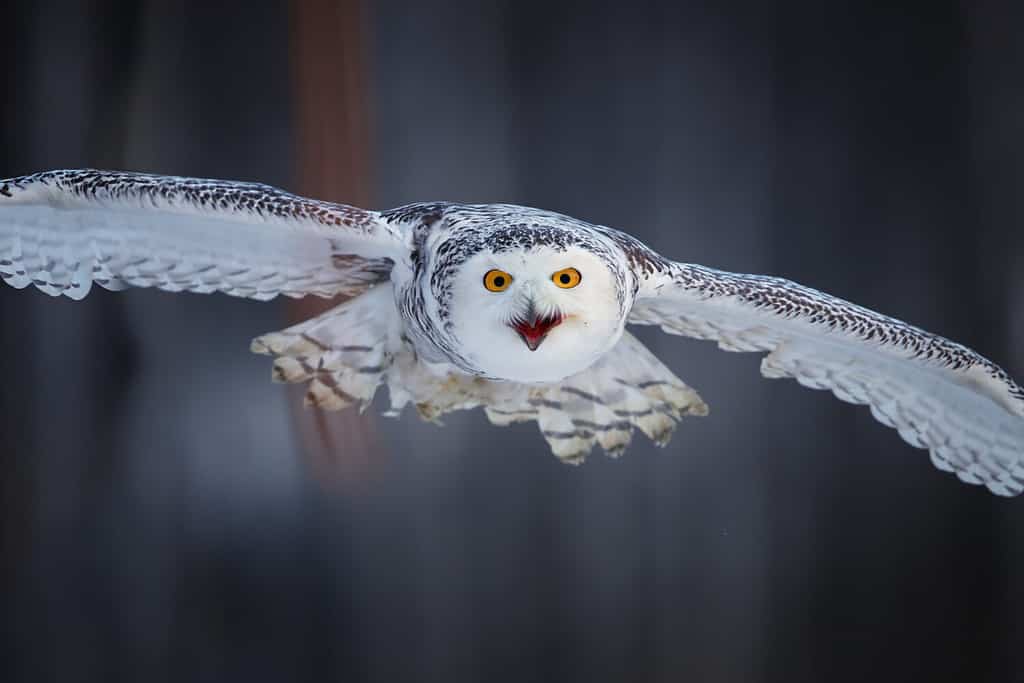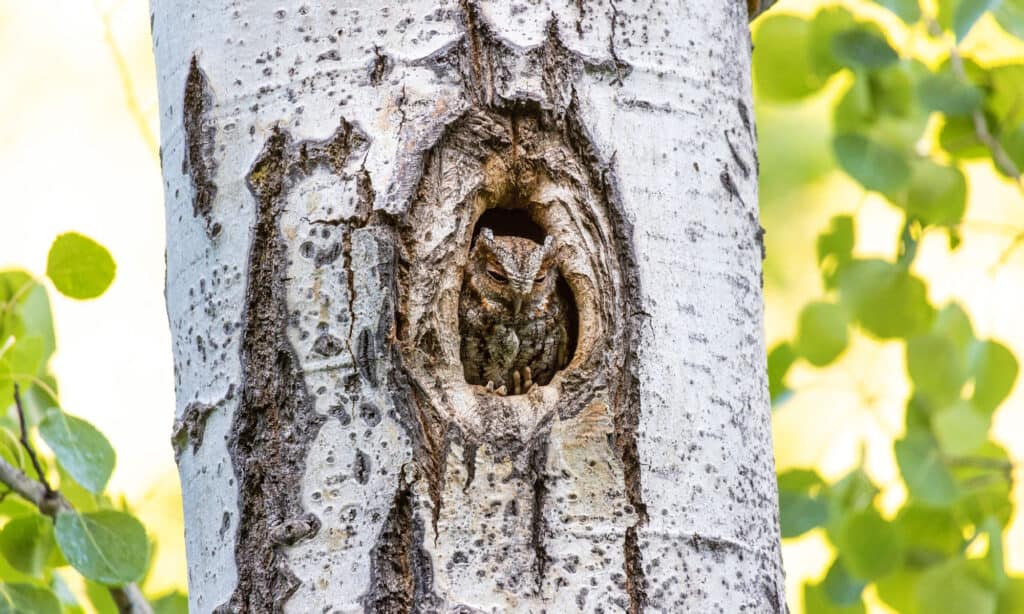The world is home to 254 different species of owls. The International Ornithological Committee (Or the International Ornithologists’ Union) is a group of people who share a global discipline in the study of all levels of avian biology. This Union recognizes 254 species of owls in two separate families. Most owls fall in the family Strigidae, while the others are in the family Tytonidae. Whether an owl is in one family or the other probably matters less to the owl than where it will sleep at night. Where do owls sleep at night? In nests, of course. So, then, where do owls nest? Let’s explore this question and learn a little bit more about our winged friends.
What are Owls?

This is one example of a
barn owl
from the family
Tytonidae.Only barn owls have heart-shaped faces.
©Henk Bogaard/Shutterstock.com
Owls are raptors, which are birds of prey. the word “raptor” is a bastardization of the Latin word “rapere”, which essentially means “to take (seize) by force”. The word “raptor” is widely colloquially used to describe all birds of prey. Some bird enthusiasts believe that only birds of prey that hunt during the day are raptors. However, the Owl Research Institute calls owls “raptors” and “birds of prey” interchangeably. Owls are mostly solitary and usually nocturnal. Only two species of diurnal owls exist – the Northern hawk owl and the Northern pygmy owl.
Owls descend from the order Strigiformes. About 20 species of owl are in the family Tytonidae. This family is comprised of barn owls such as the Eastern barn owl, the red owl, the golden masked owl, and the greater sooty owl. The other 234 species are in the family Strigidae and include the powerful owl, the Australian boobook, the barking owl, and the Morepork.
Five owl species, the laughing owl (Ninox albifacies), the Bermuda saw-whet owl (Aegolius gradyi), the Rodrigues scops owl (Otus murivorus), the Mauritius scops owl (Otus sauzieri), and the reunion scops owl (Otus grucheti) are extinct. Owls exist on every continent except Antarctica. They eat a diet of small mammals, birds, and insects. Some species of owls even hunt fish. A band of owls is called a “Parliament”, perhaps because owls often look so wise.
Common Owl Features

You can see the round, flat face and the forward-pointing tubular eyes of a classic owl in this incredible shot of a
snowy owl
in flight.
©Martin Mecnarowski/Shutterstock.com
A lot of owls have great similarities. They share a large, flat face with big orb-like eyes. Most owls have hawk-like beaks, upright stances, and very sharp talons. They need these talons as hunting birds to catch their prey. Their feathers are specially adapted for the quietest flight. Owls all have feathers that help them in a variety of ways. Not only do their feathers help them with silent flight for hunting, but their facial feathers help them hear better! Owls can move the feathers on their faces to better funnel sound. This keen ability helps owls pinpoint the location of small prey and sense incoming danger.
Owls always have round or heart-shaped faces and stocky bodies. All owls have the sharp, hooked beaks and pointed talons of raptors. Most owls have very flexible necks and can rotate their heads up to 270 degrees. This is to compensate for the tubular nature of their eyes. Owls have somewhat telescoping eyes, which are great for visual acuity but not so effective in the lateral rotation department. The owl has evolved to be able to rotate its head an astounding amount in order to combine its visual acuity with a wide range of sight.
Where do Owls Nest?

In the image above, a flammulated owl sits in the hollow of a birch tree. These hollows make perfect nests for a wide variety of owl species across the globe.
©iStock.com/Devonyu
Owls most commonly nest in trees. Owls prefer holes in trees rather than building a nest, and these holes are called “hollows”. Hollows are both naturally formed and created. Some hollows are the result of woodpeckers. Regardless, owls love to nest in all sorts of trees with cavities and hollows. Some species of owls dwell in the desert, where there are very few trees. Elf owls will nest in the hollows woodpeckers make in saguaro cacti. Some of these cacti get as tall as trees and provide wonderful protection for anything living in them.
Barn owl species are just as likely to nest in the rafters of old buildings. Perhaps that’s where they got their names. Barns, silos, and other vacant buildings are great spots for these owls. They also like to nest in owl-sized caves on cliffsides.
What about burrowing owls? Yes, it’s true! Some owls prefer to live underground. Most burrowing owls will not dig their own burrow, contrary to their name. They inhabit the old homes of prairie dogs or other ground squirrels and burrowing animals. Some burrowing owls do dig their own burrows, though, and other owls build a simple nest directly on the ground.
Owls don’t care for the nest-building aspect of where they nest. Excellent hunters and not so good at craftsmanship, an owl will almost always prefer a nest that has already been left behind.
What are Owl Nests Made of?
Most of the nests owls inhabit are built before they get there. Because of this, the nests are built from a wide variety of materials. This includes feathers, straw, string, fur, hair, leaves, twigs, bark, and other found materials. Sometimes the nest will achieve extra cushion and lining from accumulated prey. Owls might also regurgitate pellets in their nests which eventually works into the lining, as well. Mostly, though, it’s more of a pre-furnished rental situation. The owl finds a place it likes and just moves right in.
Owls in the United States

The
Elf Owl
(
Micrathene whitneyi) is the smallest owl in the world.
©Agami Photo Agency/Shutterstock.com
We are sure of 19 separate owl species in the United States. Every state in the United States has an owl population, but a couple of states go above and beyond in the owl department. For example, Oregon has the most owls out of any state, while Florida has the most species of owl in any state.
The great horned owl is the most common owl species in the United States while the Elf owl is the smallest. Habitat loss threatens both of these birds.
When and Where to See Owls
Owls inhabit a wide variety of habitats. They can be seen in deserts and across tundras, in marshes and swamps and old-growth forests. Many owls inhabit mountainous regions or areas with a lot of coniferous forests. Some owls, like the snowy owl, even live as far north as regions around the North Pole, making the snowy and formidable tundra their home. Owls only need food, a perch, and a safe nest to survive, so it is little wonder that they are found across so many diverse biomes.
Most owls are nocturnal, meaning they spend their waking hours in the darkness of the night. A great time to try to see owls is actually around dawn before they end their day. Many people have spotted owls right before sunrise. If you’re not an early riser, you can try Sunset, as well. Clear nights with a full moon might bring you luck, as well. Catch the sound of your local owl population hooting away or maybe even see the silhouette of one of these great birds as it swoops across the night sky.
Either way, we don’t have to warn you not to interact closely with these magnificent birds. Owls are very private creatures and it is unlikely you’ll draw too close to one or put it in danger. Remember to always respect natural habitats and practice moving quietly through the areas you’re exploring. You’re much more likely to see some wildlife that way, and nature thanks you for it, too.
The photo featured at the top of this post is © Albert Beukhof/Shutterstock.com
Thank you for reading! Have some feedback for us? Contact the AZ Animals editorial team.






